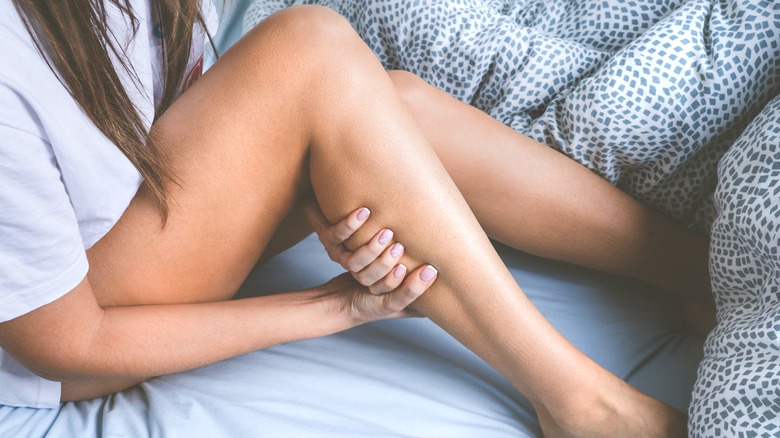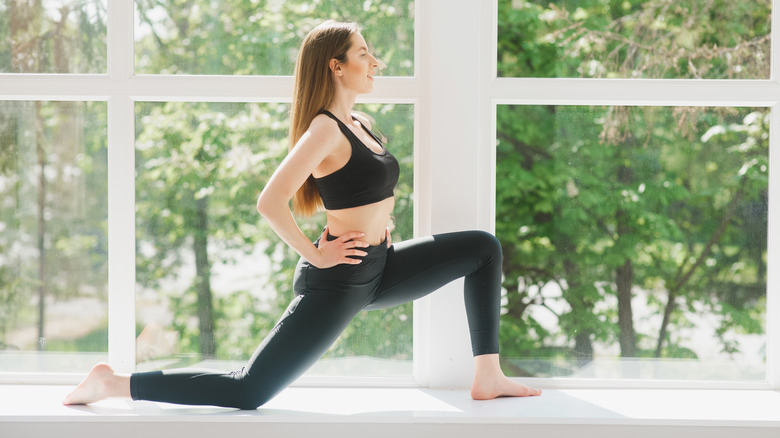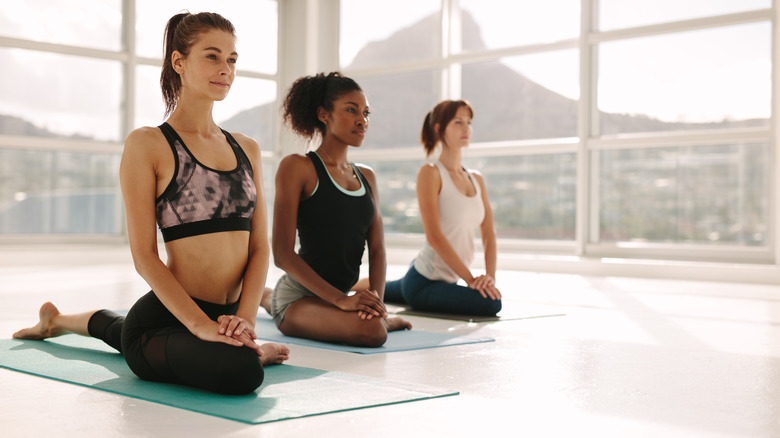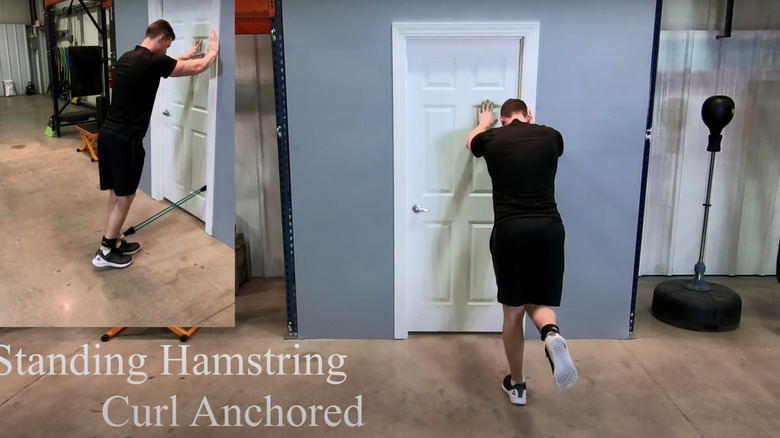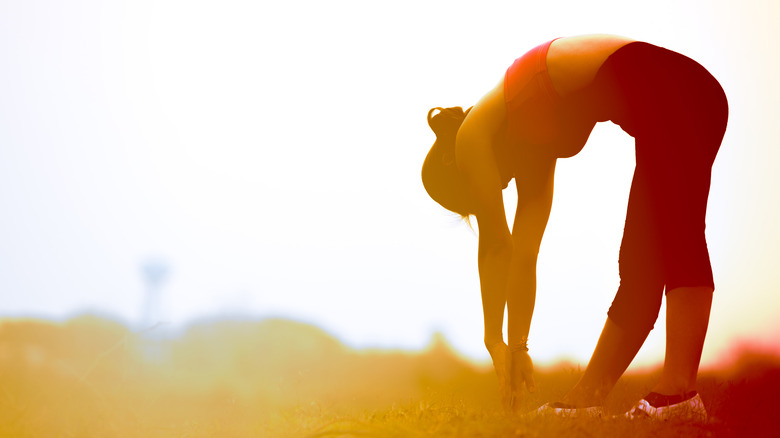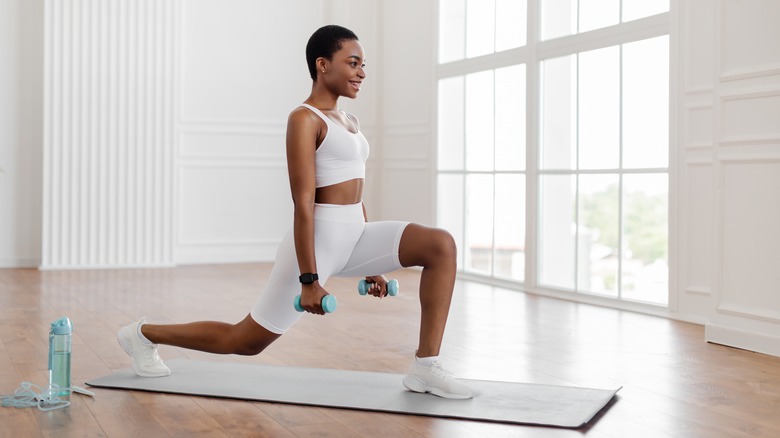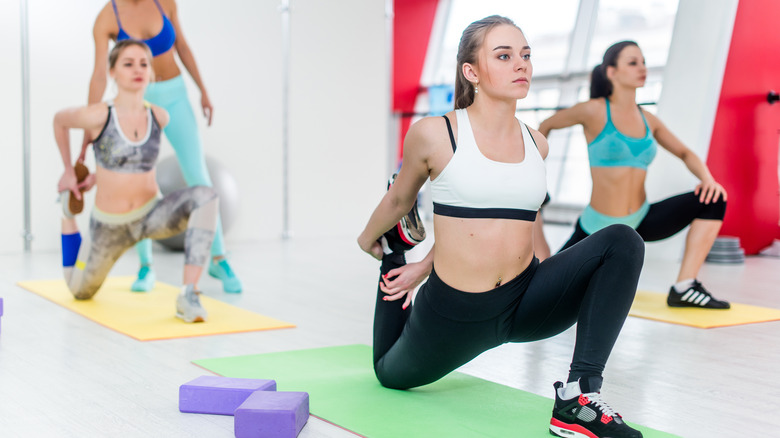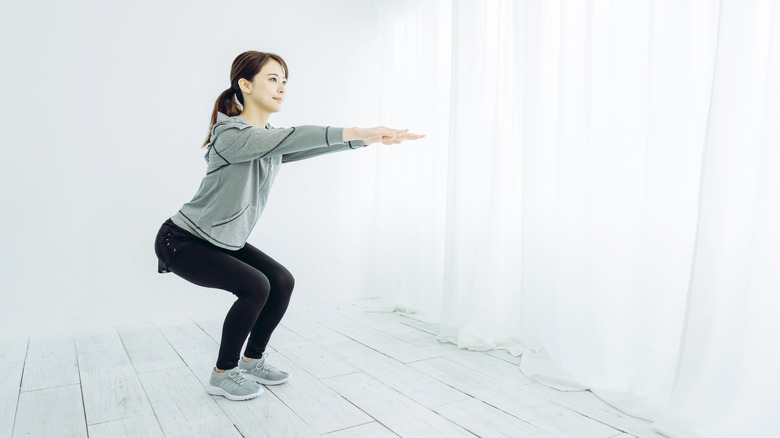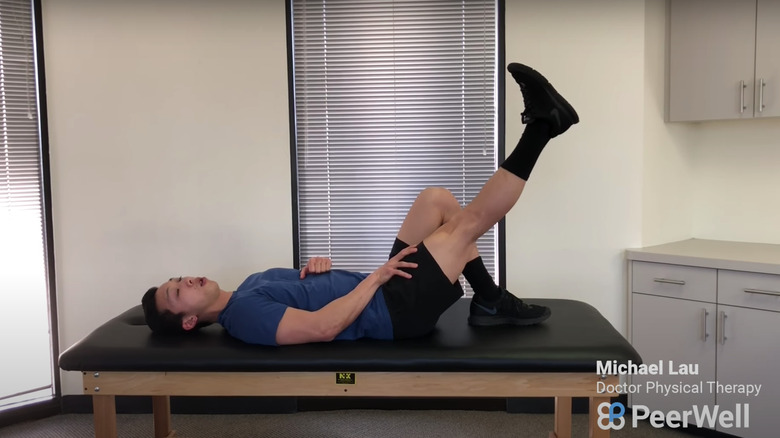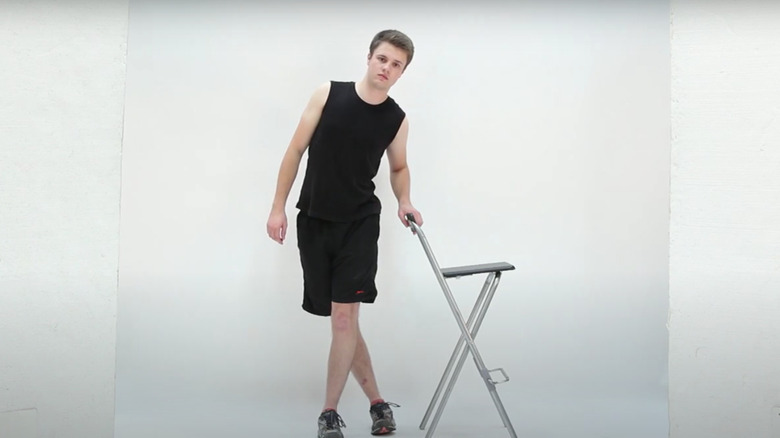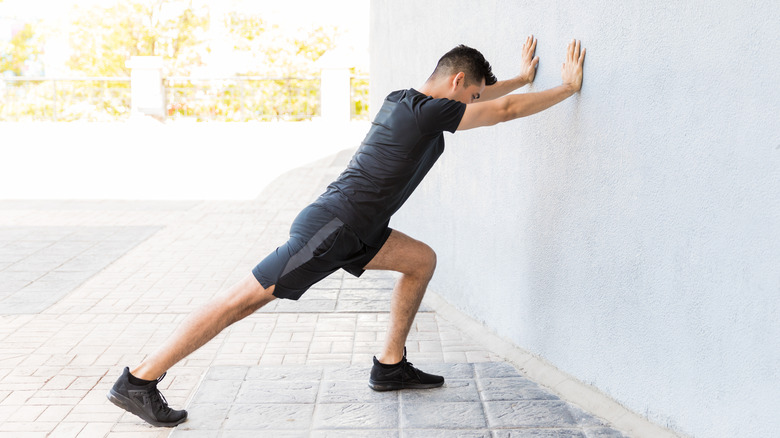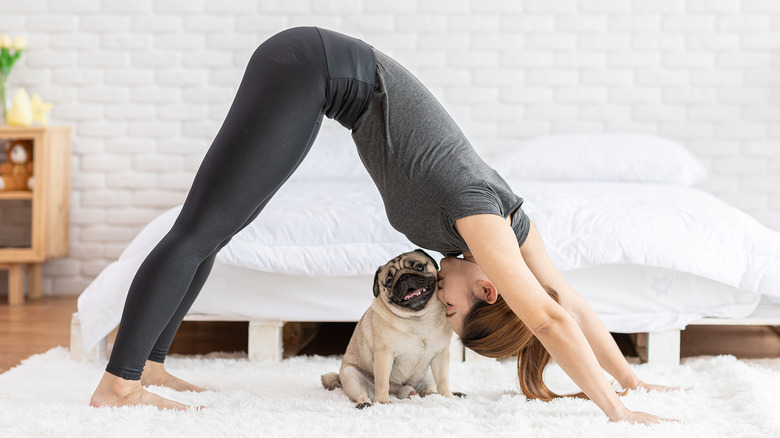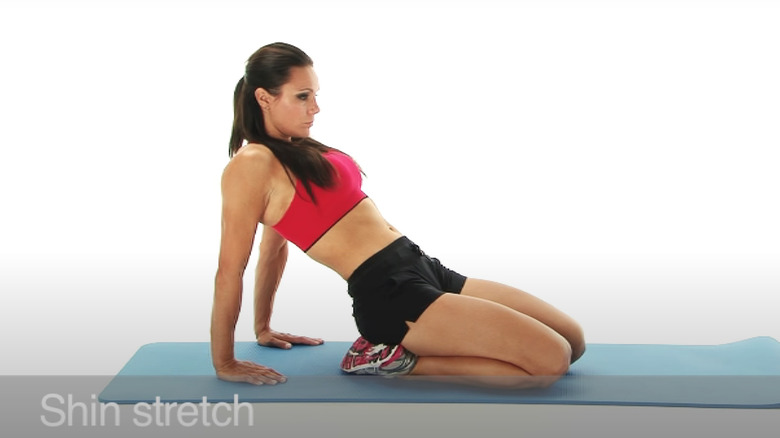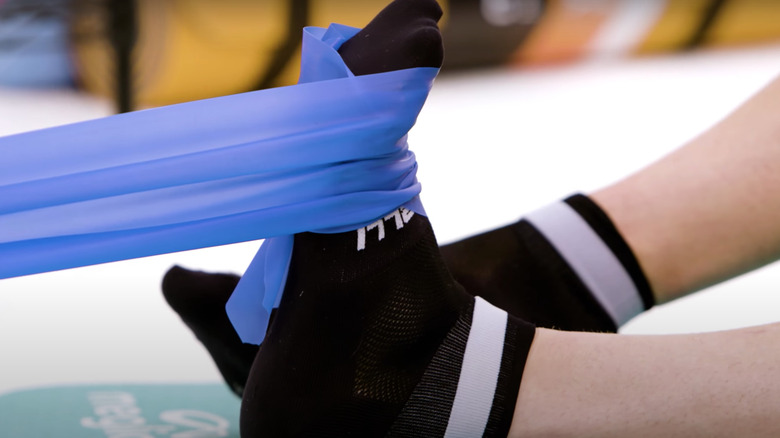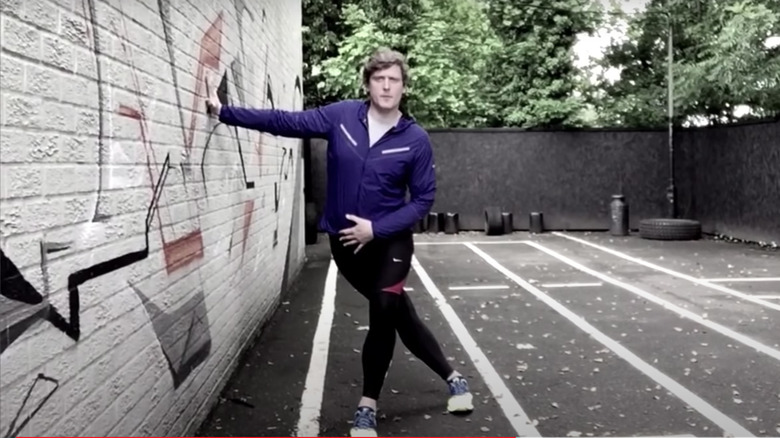The Best Exercises For Leg Pain
We all know the score. You're a few months into a new workout routine, and your legs are feeling pretty good. And then, bam. You feel a painful twinge, twist your knee slightly when you're squatting, or your hamstring gives out during a jog. Or, you've been working out too hard, and now they're aching something fierce.
Whatever the reason, leg pain can range from a minor annoyance to a total obstruction to your day-to-day activities. And it can come from anywhere: from a sports injury to a condition like deep vein thrombosis or peripheral artery disease (per WebMD), or delayed onset muscle soreness (per Self). Whatever the cause, it's important to tend to your legs when they're in pain, to make sure they bounce back stronger than ever. And that's where exercise can come in. From your thigh to your knee, there are multiple exercises and stretches out there that can help — and remember, stretches count as exercise too, says certified exercise physiologist John Ford to NBC News. Let's look at some of the best ones you can do for leg pain.
Kneeling hip flexor stretch
Our hip flexors may not be the go-to muscle we exercise every time we work out, but you use them a lot. Hip flexors help us lift our knees toward our bodies, connecting the torso and the thigh — and when they get injured, boy do we know (per Healthline). Overuse of our hip flexors can occur quickly and as a result of a large range of activities, leading to strain.
Luckily, a simple kneeling hip flexor stretch can help ease pain and rehabilitate the muscle. To perform the stretch, kneel on the floor in an upright position, and place your uninjured leg out in front of you, knee bent with your foot planted on the floor, your injured leg in line with your body, say MyHealth.Alberta.ca. It can be helpful to place a soft item like a towel below your knee to cushion it from impact with the floor. Gently lean forward into your bent knee until you feel a stretch running up the top of your thigh where it meets your pelvis. Hold the stretch for around 15-30 seconds, making sure to breathe, and to ease off if you feel any pain. Rest, and repeat several times.
Pigeon pose
Our hips take a lot of impact throughout our lives. And, incredibly, you may not even have to be doing anything for them to feel the strain — simply sitting down for extended periods can cause your hips stress. "When you sit with your knees bent, your hamstrings are in a relaxed, shortened position, and your hip flexors are at the maximum shortened length," says physical therapist Kirsten Zambon to Franciscan Health. When you do this over an extended period (all day every day, for example), your hips can lose strength. Weakness and pain can be exacerbated by having poor posture while you sit, advises Zambon.
Luckily, the hip-opening pigeon pose is a perfect exercise to relieve pain and tightness in your hips (per Verywell Health). Begin in a downward dog pose, and then bring one knee down and through as though you were going into a lunge — but instead of placing your foot on the floor, allow your knee to come to the ground. Keep your hips facing forward, and allow your back leg to come down to the floor. Slowly lower the rest of your body, breathing into the stretch. The pigeon pose can be quite intense, so if you're new to it, keep your hands firmly on the floor, and only lower down as much as you're comfortable doing so.
Standing hamstring curl
The hamstring is one of the most important muscles in our legs, and unfortunately, it's also pretty prone to injury. Occurring as a result of muscular overload, hamstring strains are particularly prevalent amongst people practicing activities that have jumps or sprints in them, says Nemours TeensHealth. If you've experienced a torn or strained hamstring, specific exercises are one of the best things you can do to gently reintroduce motion back into the area (per Verywell Health).
A standing hamstring curl is ideal for this. Standing next to a cable pulley machine, attach a cuff attachment on the bottom rung, place the cuff around your lower leg, and steady yourself against the frame with your hand (per ACE Fitness). Bring your weight onto your supporting leg, and slowly curl your cuffed leg back and up, until your knee is at a 90-degree angle. Pause briefly, and then lower your leg. Depending on the strength of your hamstring and the severity of your strain, you may want to start with no resistance entirely, adding it in incrementally as you build your motion back up.
Standing hamstring stretch
Hamstring pain can present itself for a variety of reasons, and sciatica can be one of them. Occurring when the sciatic nerve becomes compressed due to inflammation or pressure from a herniated disc, sciatica may cause pain down the back of the leg, as well as numbness (per Mayo Clinic). Having tight hamstrings may make sciatica worse, and exercising and stretching out the muscle can reduce pressure around the nerve and make symptoms less severe, says Spine-health.
And for this, you can't get better than a standing hamstring stretch. Standing up straight, take one of your legs and cross it in front of the other one (per Verywell Fit). Allow your upper body to lower down until you're bent over, and then bring your forehead toward the knee of the front leg. Try to keep your legs from bending. Hold this position for 15-30 seconds, allowing your hands to rest on the floor if you're able to do so. Come up to your starting position, cross your legs the other way, and repeat.
Walking lunge
The muscles responsible for bending, straightening, moving, and stabilizing our legs, our quads can quickly become overwhelmed. Whether down to an uncomfortable twist or being overloaded, a pulled quad muscle can be pretty painful and debilitating, says WebMD.
And one of the best ways that we can keep our quads from getting injured in the first place is by strengthening them. One of the simplest and most effective ways to do this is with a walking lunge. Begin in a regular standing position, with your feet hip-width apart, and make sure you have adequate space in front of you (per Healthline). Take a step forward and place your front foot on the ground, bending your front knee until your thigh is parallel to the floor. Make sure your knee doesn't go forward past your foot. Then, keeping your front foot in place, stand and step your back leg forward and through, lunging it forward to repeat the motion with the other leg. Repeat this stepping motion for around 10-12 reps per leg. If you don't have a good amount of space to do a walking lunge in, you can simply raise the front leg back to your starting, standing position after each lunge.
Kneeling quad stretch
If you're a runner, you'll know the battering your quads can take during exercise. And while a consistent, safe training routine will generally keep your quads in good shape, a sudden change in the way you run, like speeding up suddenly, can affect you. "As you increase speed, you decrease the range of motion at your ankle and increase range of motion at your hip and knee," says chiropractor and The Running Clinic director Kevin Maggs to Women's Running. This can mean that your quads experience a greater impact as you swing your legs, potentially leading to strain or injury.
Keeping your quads limber through a kneeling quad stretch will aid your mobility and lessen the risk of sudden injury. Move into a high lunge, and then lower your back leg's knee to the ground, instructs Pop Sugar. When your position feels secure, take the arm that's on the same side as your back leg, reach back, and grab your toes. Gently pull your lower leg toward your glutes, feeling the stretch through the back leg's quads. Hold for 30 seconds, and then repeat with the other leg.
Half squats
Do you experience knee pain? If you do, you're far from alone. Knee pain is a particularly prevalent leg condition, affecting as many as 1 in 5 American adults (via Classic Rehabilitation, Inc.). Keeping the knee area mobile and well-stretched, and strengthening the muscles that support the joint, can help with pain management by taking disproportionate impact off your knee and delivering the load to other parts of your leg (per Healthline).
A half-squat is a great place to start with this. Half-squats allow you to build up the muscles that support the knee without causing them too much stress. Stand with your legs at shoulder-width, with your gaze facing forward. Slowly come down into a semi-squat position (you should aim to lower yourself by around 10 inches), making sure not to lower yourself too much. Hold the position briefly, and then using your heels, drive back up to standing. Repeat 10 times, for 2-3 sets.
Leg lifts
Knee injuries can be pretty limiting on your day-to-day activities, but when you're on the mend, it's important to support the joint in its healing journey (per NHS Inform). And focusing on exercises that strengthen your quadriceps will benefit you enormously in this. "The quadriceps are the primary muscles that help support the knees. If you have weakness in your quads, that can lead to a degree of instability in your knees," advises physical therapist Tim Bungo to the Cleveland Clinic. Your quads support your knees when standing and during upright movement, as well as when extending your leg. Without adequate quad strength, you can face a number of leg issues, says Bungo.
Leg lifts are a gentle way to introduce activity in the quads post-injury. Start by lying flat on your back, with your legs outstretched, says Medical News Today. Bring one leg up so that it's bent with your foot flat on the floor, and then while engaging your abs, raise your flat leg, keeping it extended until it's at around a 45-degree angle to your body. Hold it there for several seconds and then lower it to the ground. Repeat a few more times, resting between sets.
ITB stretch
Unless you're a doctor or physical therapist, you'd be forgiven for not being aware of the existence of the iliotibial band. But not only does your iliotibial band (or ITB), a mass of fibers snaking from your outer hip to your shinbone, play an important function in the movement of your leg, but it can become injured pretty fast (per WebMD). When iliotibial band syndrome occurs, the ITB tightens and inflames due to the friction generated when the band moves over your knee repeatedly. Commonly seen in runners or cyclists, when this happens, it can make moving the joint tricky.
While resting the leg following ITB syndrome is important, certain exercises can assist your recovery and generate mobility in the band. To do an ITB stretch, stand upright and cross one leg in front of the other, placing your foot on the floor, says the National Health Service – to be clear, the back leg will be targeted in the stretch. Lean gently in the opposite direction that the front leg is crossed over to (so, if your right leg is crossed over your left, lean to your right side), and allow your hip to push out in the opposite direction. Maintain an upright position, not bending forward or backward, and hold for 15 seconds, repeating several times.
Calf wall stretch
Although a large number of conditions can cause calf pain, you're far more likely to experience it if you perform exercise that involves them regularly (per the Cleveland Clinic). When the calf muscle is overworked or overstretched, muscle strain can occur.
Your calf muscle strain will generally clear up on its own, and incorporating low-impact exercise while you're in recovery can help you get back on your feet (quite literally!). And there are few calf muscle exercises as simple as the calf wall stretch. Begin by standing upright, facing a wall with a fair amount of distance in front of you, and then step the unaffected leg toward the wall (per MyHealth.Alberta.ca). Put your hands against the wall and lean into your front leg, keeping your back leg straight. Make sure not to overextend on the stretch — it should be gentle, but you should still feel it. Hold it for 15-30 seconds, and then slowly return to your starting position. Repeat a few times, stretching out the other leg if necessary.
Downward dog
It's hard to overstate the benefits of yoga, with the exercise practice providing positives for everything from your mental health, immunity, sleep quality, bone and joint health, and self-esteem, says Healthline. But if that wasn't enough, one of the key benefits of yoga is to help flexibility and gently activate muscles, making it a great option for anyone undergoing rehabilitation following injury.
Of all of the yoga poses out there, downward dog is one of the best for your legs. Stretching out your calf and hamstring muscles, downward dog also activates your arms and obliques, making this a full-body stretch that's a staple of any yoga routine (per Verywell Fit). Downward dog is best started from your hands and knees, with your limbs stacked straight under your shoulder and hip joints. Bring your toes under, and then, using your hands to push you backward, come up off your mat, sending your hips back so that your legs and arms are straight. Allow your weight to come back somewhat into your heels — they don't have to be connecting with the floor, but there should be a sense of downward movement through them so that you feel the stretch down the backs of your legs.
Shin stretch
When was the last time you stretched out your shins? It's probably been a while, right? With such huge, important muscles in our legs, our shins can sometimes take a back seat, but when you feel them, you really feel them. Anyone who's experienced shin splints — tenderness or pain that can radiate across the shin area — can attest to this (per the Mayo Clinic). Frequently caused by a sudden escalation in physical activity, if left unaddressed, shin splints can eventually progress to a full-on stress fracture.
While changes like supportive footwear or movement analysis can help address spin splints, introducing movement in the area through simple exercises can also reduce aches (per Active). Try stretching out the area with a simple shin stretch. Kneel on the floor with your feet under your legs and glutes, and the tops of your feet flat against the ground. Place your hands behind you on the floor, and then gently lean your body back into them. Your knees may start to lift off the ground slightly while you do this, and that's okay — what you want to feel is a stretch through the front of your lower leg. Hold the stretch for 20 seconds, for about three reps.
Anterior tibialis strengthening
Although shin splint pain is located in, well, the shin, there's more to treating your skins than just addressing the area itself. In short, you need to consider what's going on throughout your whole leg. "Strengthening of ankle and foot muscles as well the knee, hip, and core for more efficient mechanics" can support your shin area and not only prevent injury, but assist in the treatment of pain, according to Massachusetts-based physical therapist Jody Coluccini to Healthline. And one little-known area to consider keeping strong is closer to the site of shin pain itself, the anterior tibialis, a muscle running across the front of your tibia, with an easy strengthening exercise.
Begin by locating a sturdy object that you can tie an exercise band around, like an exercise station or heavy table. Sit in front of it and loop the band around the object and over the top of your foot. Slowly flex your foot up over a few seconds, hold at the top briefly, and then allow it to return to the starting position. Repeat for 10-20 reps and 2-3 sets.
Standing TFL stretch
Outer thigh pain can be a tricky thing to deal with. Potentially occurring due to many reasons, from muscle injuries to nerve, bone, or joint conditions (per Medical News Today), the difficulty in targeting the area can present problems for treatment. "Due to its location on the body, it can be a challenging area to stretch by yourself. Generally it requires stretching tools or placing your body in specific positions which may be challenging if you are just beginning your flexibility journey," states certified strength and conditioning specialist Austin Martinez to Well+Good.
Luckily, the standing TFL stretch — which targets the tensor fascia latae, a muscle running along the outside of the hip and thigh — can be fairly easily performed. Begin by standing with your feet shoulder-width apart, and then cross one ankle behind the other. Bend the knee of the leg that's in front, and then push your hip out to the opposite side. It may help to hold onto a chair or table while you do this, to remain stable. Maintain the stretch for 20-30 seconds, and then return to the beginning position, repeating on the other side.
